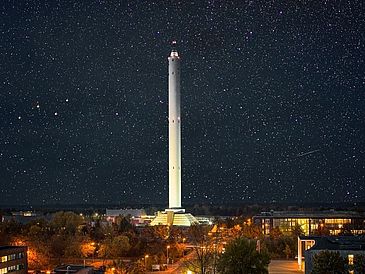“You are unlikely to find someone who isn’t by fascinated by our solar system with the Sun, the planets, comets, and asteroids. The same can be said about other stars with their planets, pulsars, galaxies, and even black holes, and the universe as a whole,” says Professor Claus Lämmerzahl from the University of Bremen’s Center of Applied Space Technology and Microgravity – ZARM (Zentrum für angewandte Raumfahrttechnologie und Mikrogravitation). Professor Lämmerzahl is organizing the 2022 Annual Meeting.
The 200 or so astronomers will discuss a wide range of topics with international guests in Bremen. There will be a discussion on the Transiting Exoplanet Survey Satellite (TESS) and its mission goals of searching for exoplanets and observing binary systems. The agenda also includes talks on the James Webb Space Telescope, which looks deep into the universe’s past and investigates conditions on exoplanets. The eROSITA X-ray satellite, which observes black holes and galaxies in addition to searching for dark matter and energy, will be a topic of discussion. The event will include talks on the Solar Orbiter and Parker Solar Probe missions investigating our Sun. Missions to asteroids and comets will also be covered, such as the highly successful Hayabusa mission to the Ryugu asteroid.
“Earth-based telescopes – such as the planned Square Kilometre Array in South Africa and Australia, which consists of hundreds of radio telescopes – are also on the agenda,” says Professor Lämmerzahl. “With the radio observatory, pulsars can be measured with the utmost accuracy and thus gain new insights into general relativity theory, as well as the physics of neutron stars.” The observations and associated research are accompanied by technical challenges such as big data.
Prizes, Lectures, Excursions and More
In addition to lectures and award ceremonies for outstanding achievements in astronomy, the event includes the AG members’ meeting, a Council of German Observatories meeting, as well as meetings organized by the Young AG, Astronomy and Education, Public Outreach in Astronomy, and the AstroFemaleNetwork. The program is rounded off by excursions to the Olbers Planetarium in Bremen, the Telescopium in Lilienthal, the OHB aerospace corporation, the German Institute of Space Systems – DLR (Deutsches Zentrum für Luft- und Raumfahrt), and the ZARM.
One of the highlights of the conference is open to the public: The initial findings from the James Webb Space Telescope as well as planned research will be presented at a public lecture at the Überseemuseum in Bremen on Thursday, September 15, at 8 p.m. “After more than three decades of development, construction, integration, and testing, this telescope was launched into space from French Guiana on Christmas Day 2021. The presentation provides a general overview of the scientific issues involved in this mission, the enormous technical challenges that had to be overcome in the construction of this astonishing satellite, as well as insights into the initial scientific findings and possible breakthroughs that are expected in the future,” says Professor Lämmerzahl.
In addition, a professional development course for teachers will be held on Friday, September 16, at 2 p.m. Both events are free of charge. Teachers wishing to take part in the course can register by sending an email to ag2022protect me ?!astronomische-gesellschaftprotect me ?!.de.
AG President: “ZARM Is One of the Leading Research Centers”
“Thanks to the Center of Applied Space Technology and Microgravity (ZARM), Bremen is one of the leading research centers for basic research and the development of technologies for space missions and microgravity experiments,” says Professor Michael Kramer, President of the AG. “We are therefore delighted to be a guest here – and we would like to thank the University of Bremen for hosting the Astronomical Society’s 2022 International Annual Meeting.”
The Twitter hashtag for the event is #ag2022bremen. Media representatives are cordially invited to attend the annual meeting. Journalists and science bloggers are asked to send an email to the organizing committee (ag2022protect me ?!astronomische-gesellschaftprotect me ?!.de). Media registration is free of charge.
Further Information:
ag2022.astronomische-gesellschaft.de
www.uni-bremen.de/en
Contact:
Professor Claus Lämmerzahl
Local meeting leader
Center of Applied Space Technology and Microgravity (ZARM)
University of Bremen
Tel.: +49 421 218-57834
Email: claus.laemmerzahlprotect me ?!zarm.uni-bremenprotect me ?!.de
Dr. Janine Fohlmeister
Press officer for the Astronomical Society
Phone:+49 331 7499-802
Email: pressereferentinprotect me ?!astronomische-gesellschaftprotect me ?!.de

